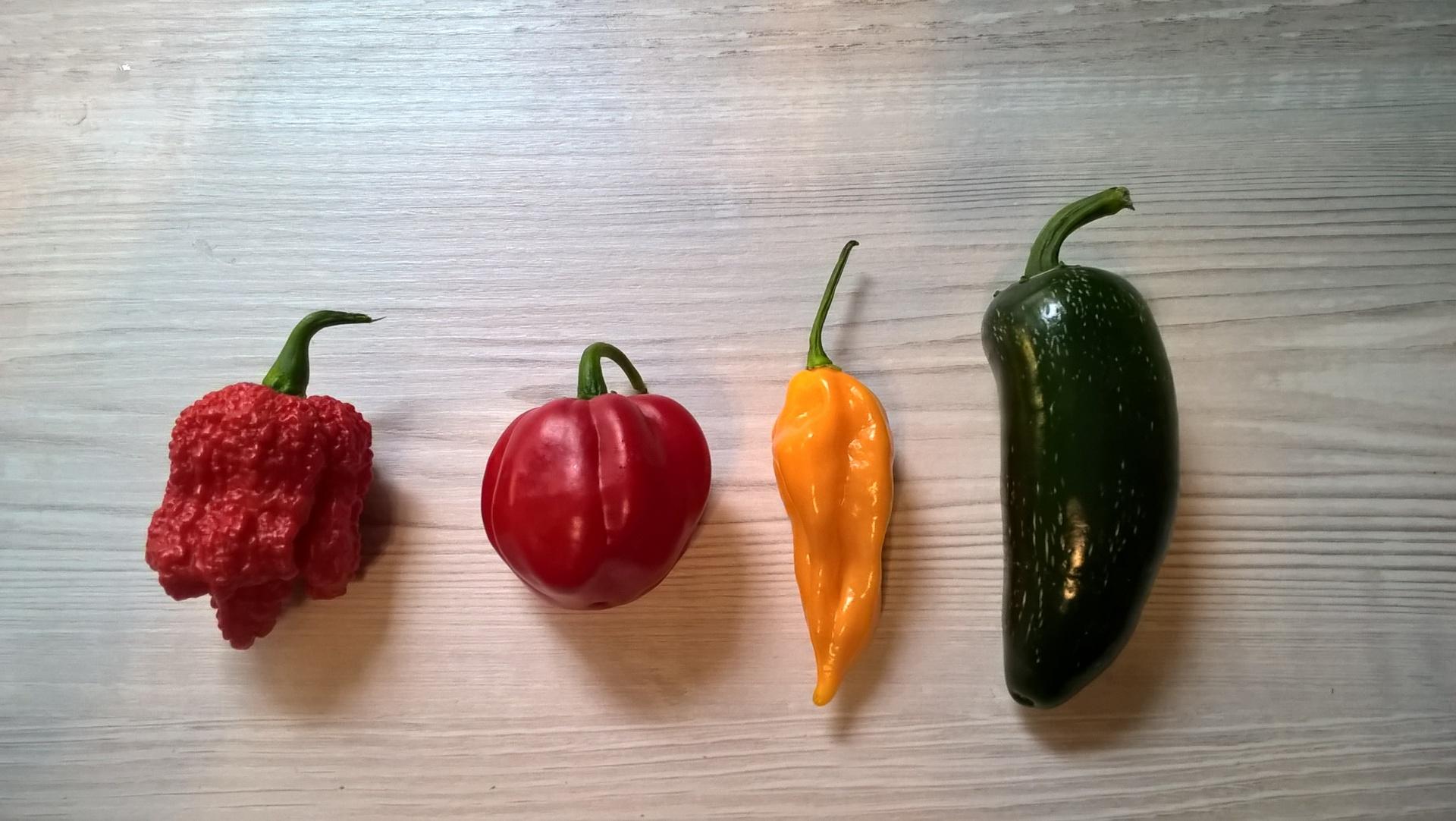The first thing that comes into mind when we hear the word “pepper” or “chili” is “hot and spicy” regardless if they are fresh or dried peppers.
Peppers are a large group of fruit-bearing plants and they are diverse in terms of their botanical classifications. A little complicated because black peppers are separate from the capsicums and they are not even related. And not only they are diverse, but also their pungency or spiciness are scored.
Table of Contents
Scoville Scale
Named after its creator, Wilbur Scoville, this scale measures the spiciness of peppers and other spicy foods. It is recorded in Scoville Heat Units (SHU). It measures the concentration of capsaicin, a compound found in chili peppers.
The score ranges from 0 to over 3 million depending on the species of chili pepper. Sweet bell peppers have a score of zero SHU while the Carolina Reaper scores from 1.6 million to 2.2 million SHU. This makes the California Reaper an extremely hot pepper. It currently holds the Guinness Book of World Record since 2012.
Drying chili peppers is something common across all cultures. You may notice a difference in flavor between regular and dried peppers. Since the moisture is removed from the dried pepper, the flavor becomes intensified and the heat factor increases. In this article, we will focus only on the Capsicum group because it is here that we will encounter most of the green and red hot chili peppers we know or might have heard of.
Capsicum
Generally called the peppers, Capsicum is a genus of flowering plants under the family Solanaceae which are native to southern North America and South America. Because of world trade in early civilizations, peppers are cultivated worldwide giving rise to different cultivars and has become a key ingredient in many cuisines.
The term Capsicum may have come from the Latin word “capsa”, meaning “box” that refer to the pods. Or it may have come from the Greek work “kapto”, meaning “to gulp”. The term “pepper” comes from the similarity of spiciness to Piper nigrum, the black pepper, although they are not botanically related. The term “chili” (“chile” in Mexico) comes from the Nahuatl word “chīlli”, a large Capsicum variety that has been cultivated since 3,000 BC.
The fruit contains capsaicin (methyl-n-vanillyl nonenamide), a chemical that produces a strong burning sensation in the mouth. Capsaicin is present in large quantities in the fruit’s placental tissues which holds the seeds, on its inner membranes, and in the white pith around its seeds but not much in the seeds itself.
Different Terms
In American English, any pepper that lacks heat is known as sweet pepper and any pepper that has a block shape is known as bell pepper. Any variety that produces capsaicin is known as hot or chili pepper.
In British English, the sweet varieties are referred to as peppers and the spicy varieties are referred to as chillies.
In Australian English, capsicum refers to the bell peppers while the spicy varieties are referred to as chilli.
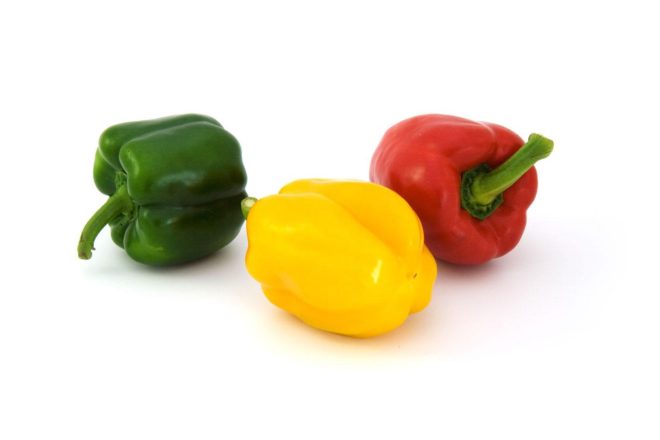
Nutritional Value and Usage
Peppers are highly nutritious. They contain more vitamin C and B6. Dried peppers have much different nutritional value due to dehydration and concentration of vitamins and minerals.
Peppers can be eaten raw or cooked. They can be preserved by drying, pickling, freezing, or in the form of a jam. Dried peppers may be rehydrated whole or processed into flakes or powders.
A List of Familiar Peppers
There are perhaps 50,000 Capsicum cultivars grown worldwide and there are five major species of cultivated Capsicum. Below is a list of familiar peppers we might have used and heard of.
C. annuum
C. annuum varieties are native to southern North America to South America but has been cultivated worldwide for more than four centuries. They have become varied in size, color, taste, and spiciness.
| Photo | Name | Heat | Pod Size | Description |
 |
Anaheim pepper (New Mexico chile, Hatch chile, California chili, or Chile seco del norte) |  0–70,000 SHU 0–70,000 SHU |
They are wide at the top and either blunt or tapered at the bottom. Usually 5 to 7 inches long and 1 to 2 inches wide. | Starts out as long, bright green chili and turns bright red when ripe. When dried, the chili turns a deep burgundy color and have a smooth matte finish. Although mild in terms of heat, the flavor is sharp and a bit acidic. |
 |
Banana pepper (yellow wax pepper or banana chili) |  0–500 SHU 0–500 SHU |
Has a curved shape and yellowish color similar to a banana. Measures 2 to 3 inches long. | Has a mild, tangy taste. While typically bright yellow, it is possible for them to change to green, red, or orange when ripe. |
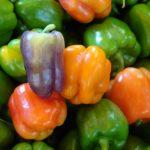 |
Bell pepper (sweet pepper, or capsicum) |  0 SHU 0 SHU |
Large bell-shaped peppers in different colors including red, yellow, orange, green, white, and purple. | The only member of the genus Capsicum that does not produce capsaicin |
 |
Bird’s Eye chili (Thai chili) |  50,000-100,000 SHU 50,000-100,000 SHU |
Small, conical, tapering fruit, 0.8 to 1.2 inches long | Often confused with a similar-looking Labuyo chili from C. frutescens |
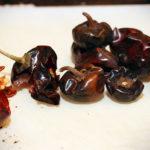 |
Cascabel (bola chili [fresh], chile bola [fresh], little bell, rattle chili [dried]) |  1,500–2,500 SHU 1,500–2,500 SHU |
Small, ball-shaped, fresh cascabel measures 0.8 to 1.2 inches in diameter | Fresh chilis turn from green to red, but color darkens when dried. The name came from the tendency of loose seeds to rattle when dried and shaken. |
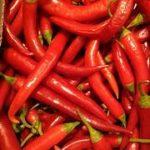 |
Cayenne pepper (red pepper) |  30,000–50,000 SHU 30,000–50,000 SHU |
Tapering, skinny fruit with a curved tip and somewhat rippled skin that measures 3.9 to 9.8 inches long | A moderately hot chili pepper, mostly red, generally dried and ground to make the powdered spice of the same name |
 |
Cherry pepper (Pimiento) |  100–500 SHU 100–500 SHU |
Large, red, heart-shaped chili pepper that measures 3 to 4 inches long and 2 to 3 inches wide | The flesh is sweet, succulent, and more aromatic than the red bell pepper. Some varieties like the Santa Fe Grande are hot. |
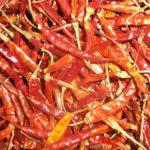 |
Chile de árbol (bird’s beak chile, rat’s tail chile) |  15,000 – 30,000 SHU 15,000 – 30,000 SHU |
Measures 2 to 3 inches long and 0.26 to 0.39 inches in diameter. | Peppers start out green and turn bright red as they mature. They are often used to decorate wreaths because they do not lose their red color after drying. |
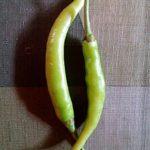 |
Finger chili (siling haba) |  50,000 SHU 50,000 SHU |
Measures 1.9 to 2.7 inches long and comes in bright light green color | One of two common kinds of native chili found in the Philippines. |
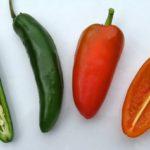 |
Fresno chili pepper |  2,500–10,000 SHU 2,500–10,000 SHU |
Mature Fresno pepper is conical in shape, 2 inches long, and about 1 inch in diameter at the stem | It should not be confused with the Fresno Bell pepper and it is often confused with the Jalapeño. The fruit starts out bright green changing to orange and red as it matures. |
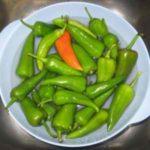 |
Friggitello (Pepperoncini,Golden Greek pepper, Sweet Italian pepper, or Tuscan pepper) |  0-500 SHU 0-500 SHU |
They are 1.9 to 2.7 inches long. Mature peppers will eventually turn red, but it is best to pick them while they are still green. | A sweet Italian chili pepper which is known in the US as “pepperoncini”. It has a mild heat and a hint of bitterness. The Greek variety is sweeter. |
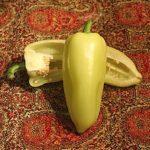 |
Hungarian Wax pepper |  1,000-15,000 SHU 1,000-15,000 SHU |
It measures between 4 to 6 inches long which tapers to a rounded point. | It is usually harvested before maturity when still yellow. Upon maturity, the pepper becomes orange then red. Although similar in appearance to banana peppers when young, it is a different cultivar. |
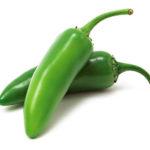 |
Jalapeño |  3,500 to 8,000 SHU 3,500 to 8,000 SHU |
A mature jalapeño chili is 2 to 4 inches long that hangs down with a round, firm, smooth flesh of 1 to 1.5 inches wide. | Commonly picked and consumed while still green, it is occasionally allowed to fully ripen and turn red, orange, or yellow. It is wider and generally milder than the similar Serrano pepper |
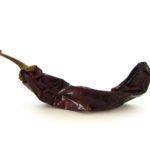 |
Mirasol (guajillo [dried]) |  2,500–5,000 SHU 2,500–5,000 SHU |
Known for its dried form, guajillo, it is one of the most commonly used chilies in Mexican cuisine. | |
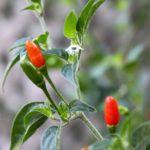 |
Pequin pepper (piquin) |  30,000–60,000 SHU 30,000–60,000 SHU |
Small oblong berries that rarely exceeds 0.8 inch long. | Commonly used as a spice. The berries start out green, ripening to brilliant red when ripe. Often 5 to 8 times hotter than jalapeños. Flavor is described as citrusy, smoky (if dried with wood smoke), and nutty. The name Pequin is thought to come from the Spanish pequeño, meaning small. |
 |
Piment d’Espelette (Espelette pepper, Gorria) |  4,000 SHU 4,000 SHU |
Cultivated in the French commune of Espelette. Fresh fruits, plants and seeds are known as “Gorria” (red). Dried fruits are called “Piment d’Espelette”. | |
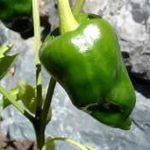 |
Poblano (ancho or chile ancho [dried], mulato) |  1,000–1,500 SHU 1,000–1,500 SHU |
Measures 3 to 6 inches long and 2 to 3 inches wide. | Unripe poblano is dark purplish green in color, but the mature fruit turns dark red that seems like nearly black. A closely related variety is the mulato, which is darker in color, sweeter in flavor, and softer in texture. |
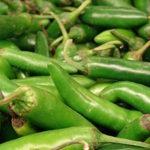 |
Serrano |  10,000–23,000 SHU 10,000–23,000 SHU |
The fruit can be harvested while they are green or ripe. Unripe serrano peppers are green, but the color varies when it matures. Common colors for the ripe fruit are green, red, brown, orange, and yellow. They are typically eaten raw and have a biting flavor that is notably hotter than the jalapeño. |
C. baccatum
These chilis have a distinctive fruity flavor and are commonly ground into powders for use in cooking.
| Photo | Name | Heat | Pod Size | Description |
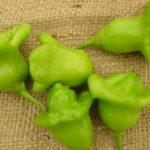 |
Bishop’s Crown (Christmas bell, or joker’s hat) |  5,000-30,000 SHU 5,000-30,000 SHU |
It has a distinct three-sided shape resembling a bishop’s crown. It grows to 1.5 inches wide. | The flesh is thin, yet crisp. They mature to red from a pale green color. The body has a very little heat, with the wings being sweet and mild. |
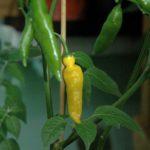 |
Lemon Drop (ají limon, qillu uchu) |  15,000-30,000 SHU 15,000-30,000 SHU |
A conical pepper that is 2.3 inches long and 0.5 inch wide with some crinkling on the skin | It is a hot, citrus-like, lemon-flavored pepper which is a popular seasoning in Peru. |
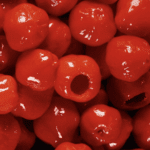 |
Peppadew® |  1,177 SHU 1,177 SHU |
Peppadew® is registered trademark and brand of food products including this type of Piquanté Pepper. Described as a cross between the resemblance in color and size of red peppers and cherry tomatoes. |
C. chinense
C. chinense or “Chinese capsicum” is a misnomer. A Dutch botanist named the species in 1776 believing that they originated in China. Most of the peppers of this species are actually South American and have distinctive and similar in flavor.
| Photo | Name | Heat | Pod Size | Description |
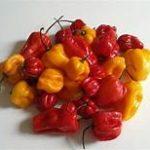 |
Adjuma (Adjoema, aji umba, or ojemma) |  100,000–500,000 SHU 100,000–500,000 SHU |
They are shaped like small bell peppers in red or yellow. Due to similarities, they are sold as Habanero, Scotch Bonnet, or Madame Jeanette. | |
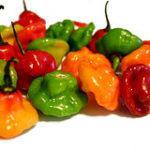 |
Ají dulce ( ají cachucha or ajicito) |  0–50 SHU 0–50 SHU |
A variety of sweet peppers with a much milder, smoky flavor. | |
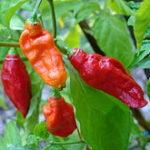 |
Bhut Jolokia (ghost pepper, ghost chili, U-morok, red naga, naga jolokia, and ghost jolokia) |  1,041,427 SHU 1,041,427 SHU |
Ripe peppers measure 2.4 to 3.3 inches long and 1 to 1.2 inches wide and comes in red, yellow, orange, or chocolate color. | Was once the hottest pepper in the world, 400 times hotter than Tabasco sauce. It is a hybrid of C. chinense with some C. frutescens genes. |
 |
Carolina Reaper (HP22B) |  1,569,300 SHU 1,569,300 SHU |
Red and wrinkled, with a small pointed tail. | In 2012, Guinness World Records declared it the hottest chili pepper in the world. Believed to be a cross between a Bhut jolokia pepper and red habanero. |
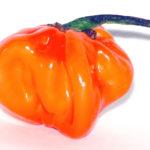 |
Habanero |  100,000–350,000 SHU 100,000–350,000 SHU |
It is roundish or bell-shaped. A ripe habanero is 0.8 to 2.4 inches long. | Unripe habaneros are green, and they color as they mature. Color variants are orange, red, white, brown, yellow, green, or purple. Used to be the world’s hottest chili pepper. |
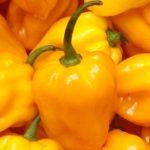 |
Hainan Yellow Lantern (yellow emperor chili) |  300,000 SHU 300,000 SHU |
This hot chili matures to a bright yellow color and is about 2 inches long and 1.23 inches wide. | It grows mainly in the southwest and southeast of Hainan Island off the coast of Southern China. Most Hainan yellow lantern chili is processed into hot sauce. |
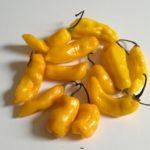 |
Madame Jeanette (Suriname Yellow) |  100,000–350,000 SHU 100,000–350,000 SHU |
The fruits are shaped like small bell peppers. peppers ripen to reddish-yellow but they are larger and unsymmetrical. | Originally from Suriname. It has hints of mango and pineapple flavors. Often confused with the yellow adjuma, which is less elongated and said to be more spicy but less flavorful. |
C. frutescens
These include the Tabascos and many of the peppers grown in Asia. Sometimes confused with or considered to be the same as C. annuum.
| Photo | Name | Heat | Pod Size | Description |
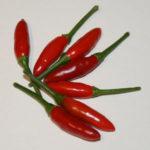 |
African Birdseye (Piri piri) |  50,000–175,000 SHU 50,000–175,000 SHU |
The fruits are generally tapered to a blunt point and measure up to 1 inch long. | Immature pod color is green, mature color is bright red or purple. |
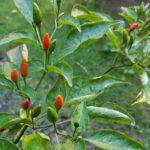 |
Labuyo chili (Filipino Bird’s eye) |  80,000–100,000 SHU 80,000–100,000 SHU |
A small, cone-shaped cultivar grown in the Philippines. Often mistaken as Thai Bird’s eye pepper. | |
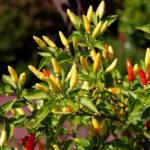 |
Tabasco |  30,000–50,000 SHU 30,000–50,000 SHU |
Tapered fruit, around 1.5 inches long, | Known through its use in Tabasco sauce. Initially pale yellowish-green and turns to yellow and orange before ripening to bright red. The only variety of chili pepper whose fruits are not dry on the inside, thus juicy. |
C. pubescens
They are among the oldest of domesticated peppers related to other undomesticated peppers that still grow in South America like C. cardenasii, C. eximium, and others. It is believed that they evolved from other more primitive Capsicum species. Pubescens refers to the hairy leaves, and along with the black seeds, this distinguishes them the from other species.
| Photo | Name | Heat | Pod Size | Description |
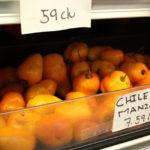 |
Canário (canary pepper, yellow Manzano) |  30,000–50,000 SHU 30,000–50,000 SHU |
Thick walled pods, dark yellow when fully ripe, and about the size of a small apple. | |
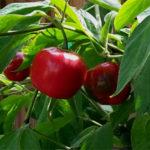 |
Rocoto (Iocoto, Manzano pepper) |  30,000–100,000 SHU 30,000–100,000 SHU |
Known for its apple-shaped fruit. |
Drying Peppers
Peppers can be dehydrated by sun-drying, air-drying, or using a home dehydrator or an oven. The finished product can be crumbled or powdered to use as a flavoring or coloring in many foods.
Soak dried peppers in water to rehydrate them for use in casseroles. Dried peppers can be stored in moisture- and vapor-proof packaging in a cool, dry, dark place for several months.
Sun-drying
Day temperatures should be higher than 85°F and humidity is around 60°F. Remove seeds, stems, and membranes before drying. Small peppers can be left whole but make a slit using a knife to speed up drying. Large peppers dry better if they are cut in half, sliced, or cut into cubes. You’ll know when peppers are completely dried when they turn brittle.

Air-drying
With a knife, make a slit on the peppers. Then using a large needle, run through a heavy thread through the stems. Hang the strings of peppers in a room where air circulates freely. High humidity may spoil the peppers before they dry. Air-drying can take 3 to 4 weeks.
Dehydrating
Dehydrator or oven temperatures should not exceed 140°F when drying peppers. Remove the seeds, stems, and membranes then slice or cut them into cubes. For small peppers, make a slit to speed up drying and dry them whole. Below is a drying guide generally for peppers.
| PEPPER | PREPARATION | BLANCHING | DRYING | CHECK FOR DRYNESS |
| Chili peppers, green | Wash. To loosen skins, cut slit in skin, then rotate over flame 6-8 minutes or scald in boiling water. Peel and split pods. Remove seeds and stem. Wear gloves if necessary. | No blanching required | 12-24 hours | Crisp, brittle, medium green |
| Chili peppers, red | Wash thoroughly. Slice or leave whole if small | 4 minutes | 12-24 hours | Shrunken, dark red pods, flexible |
| Peppers, pimientos | Wash, stem. Remove core and seeds. Cut into 1/4″ to 1/2″ strips or rings | 4 minutes | 8 to 12 hours | Tough to brittle |
If you are considering to purchase a food dehydrator, check out our recommendations.
RELATED ARTICLE: A Beginner’s Guide on How to Dry Vegetables
Final Thoughts
With so many varieties of chili and bell peppers, it could be confusing to distinguish one from the other. But for those who love spices, this may not matter much as what we are really after is the heat that it will bring to the food.
Which of the chilis would you like to dry most of the time?

